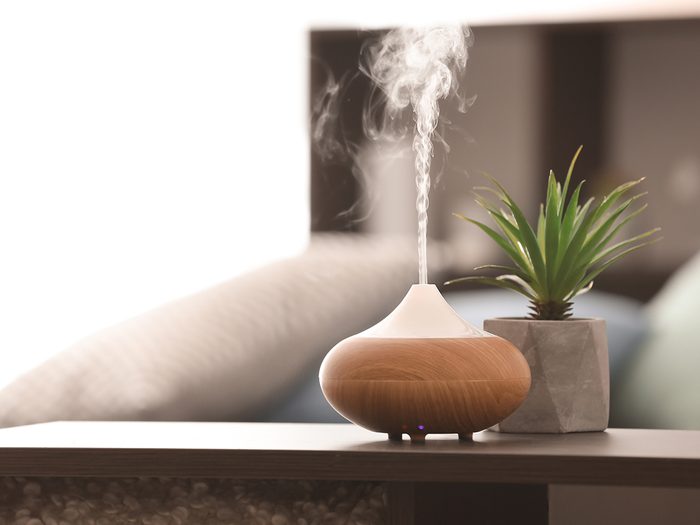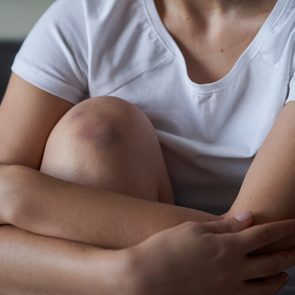This Woman’s Medical Nightmare Will Make You Think Twice About Essential Oil Diffusers

The itchy, swollen bumps on her face were becoming unbearable. The cause? An allergic reaction to the most unlikely household item...
In 2016, Janice Brisco, a Thornhill, Ontario funeral-home worker in her mid-60s, started finding the occasional bump on her face. They often appeared at bedtime as a single rose-coloured welt, about the size of an insect bite, or a small cluster. By morning, the bumps were usually swollen, red and itchy, and would take a few days to settle down. “I was wondering, do I have bedbugs?” she says. “What in the world is it?”
Although Brisco washed her bedding and mattress cover on a hot cycle, she continued to get outbreaks. They weren’t frequent, only about every other month, but they gradually intensified. Soon Brisco was having episodes in which her entire face was red and swollen. At the end of 2017, the reaction was more severe than ever: her face turned deep purplish-red, her skin drew painfully tight, and her eyelids, hit the hardest, swelled so that her eyes almost closed.
“My husband said I looked like Rocky after a big fight!” she says. “It hurt, and it was quite scary, because I could hardly see.” She booked an emergency appointment with her family doctor, who was alarmed by her condition. He recommended an antihistamine for a suspected allergic reaction and referred her to an allergist for testing. It was two or three days before her skin started to clear up again.
In January 2018, Brisco saw the allergist, who conducted skin prick testing, in which tiny amounts of allergens are scratched into the skin. She had minor reactions to a few substances, like cats and ragweed, but nothing that would account for her attacks. “I was back to square one, not knowing what it was,” she says.
“With contact dermatitis, you’re kind of like a detective”
Shortly after, at a routine appointment with her dermatologist, Brisco mentioned the episodes and shared some photos. Intrigued, the doctor suggested Brisco see Dr. Sandy Skotnicki, a dermatologist in the department of medicine at the University of Toronto. Skotnicki specializes in contact dermatitis, a skin reaction from touching an allergen or irritant—as opposed to an allergy to something eaten or inhaled, which is what the skin prick testing had looked for.
When Brisco finally made it to the top of Skotnicki’s waiting list that August, the doctor was immediately certain the cause was something coming into contact with her skin. “Janice had these dramatic, explosive photos with incredible swelling and weeping,” she recalls. Often, contact dermatitis occurs when something is applied to the skin, such as face cream, especially when people apply these products regularly. Brisco’s reactions, being intermittent, didn’t fit. Brisco couldn’t think of anything she used only sporadically. But without answers, she risked steadily worsening reactions, as her immune system learned over time to build an ever-stronger response.
Skotnicki decided to conduct patch testing. Flat, square packets, less than a centimetre in size and each holding a pad soaked with a tiny amount of a specific substance, are taped to a patient’s back for 48 hours and then removed. After another 48 hours, the patient is examined for reactions. Dozens of substances can be tested at once, but since there are several thousand potential skin allergens, the dermatologist must decide which sets (called “trays”) to use. Skotnicki has special trays for hairdressers, mechanics and other occupations; she asks about hobbies like painting and stamp collecting. “With contact dermatitis, you’re kind of like a detective,” she says.
She started Brisco with the standard tray of 85 substances, including cosmetic ingredients and clothing dyes. “My whole back, shoulder to shoulder, down almost to my waist, was covered with little white square patches,” says Brisco. Aside from the itchy adhesive tape, she couldn’t tell what was happening under the patches for the first two days. But after these were removed, while Brisco waited for her follow-up appointment, she saw in the mirror that some squares of skin were obviously inflamed.
When you’re allergic to essential oils, diffusers can be dangerous
When Brisco came in for her exam, Skotnicki noted where her skin had become an angry red and covered in a rash. Brisco tested positive to lavender and lemongrass, and was most highly allergic to ylang-ylang, a tropical fragrant tree whose extract has gained popularity as a beauty-product ingredient. The substances Brisco had reacted to are found in shampoos and perfumes, but they had something else in common: they’re sold as essential oils. At a recent conference, Skotnicki had learned about a rising incidence of allergic patients who used diffusers, which disperse essential-oil particles into the air to benefit mood or mental function. Now, she questioned Brisco.
“I was diffusing daily,” Brisco says, who’d started using an array of essential oils a couple of years before the bumps first appeared. The oils had been recommended by a neighbour, and Brisco quickly became a fan, using different kinds for different reasons. She used citrus oils like lime or grapefruit as mood boosters, and she found peppermint invigorating. And then, on occasion, she’d used the offending lavender to help with sleep, or blends that included ylang-ylang as a pick-me-up.
Of course, when essential oils are launched into the air, they come into contact with skin. “The eyelids are so thin, they get allergic reactions first,” says Skotnicki. If Brisco had continued using the oils, the reactions would have become more extreme over time, and the itchy rashes would have spread to other areas, like her ears and neck, and become debilitating. Around two to four per cent of the population is allergic to chemicals in their day-to-day products, often without knowing it, says Skotnicki. “They suffer for a long time.”
Armed with her diagnosis, Brisco can now safely avoid the essential oils she’s allergic to, and she’s careful not to get too close to her diffuser. She also uses fragrance-free beauty and cleaning products.
It’s been a lesson for Skotnicki, too. “After Janice, I’ve asked every patient about essential oil diffusers!”
Next, read up on the skin changes you should never ignore.






